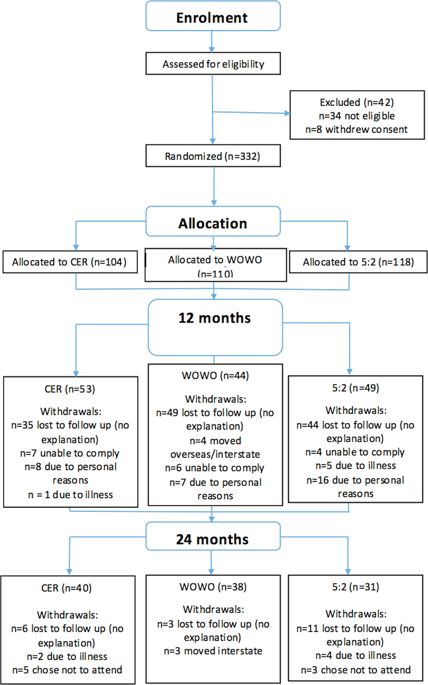International Journal of Obesity ( IF 4.2 ) Pub Date : 2020-01-14 , DOI: 10.1038/s41366-020-0525-7 Michelle Louise Headland 1, 2, 3 , Peter Marshall Clifton 1, 2, 3 , Jennifer Beatrice Keogh 1, 2, 3

|
Background and objective
Intermittent energy restriction continues to gain popularity as a weight loss strategy; however, data assessing it’s long-term viability is limited. The objective of this study was to follow up with participants 12 months after they had completed a 12-month dietary intervention trial involving continuous energy restriction and two forms of intermittent energy restriction; a week-on-week-off energy restriction and a 5:2 programme, assessing long-term changes on weight, body composition, blood lipids and glucose.
Subjects and methods
109 overweight and obese adults, aged 18–72 years, attended a 12-month follow-up after completing a 12-month dietary intervention involving three groups: continuous energy restriction (1000 kcal/day for women and 1200 kcal/day for men), week-on-week-off energy restriction (alternating between the same energy restriction as the continuous group for one week and one week of habitual diet), or 5:2 (500 kcal/day on modified fast days each week for women and 600 kcal/day for men). The primary outcome was weight change at 24 months from baseline, with secondary outcomes of change in body composition, blood lipids and glucose.
Results
For the 109 individuals who completed the 12-month follow-up (82 female, 15 male, mean BMI 33 kg/m2), weight decreased over time with no differences between week-on and week-off and continuous energy restriction or 5:2 and continuous energy restriction with −4.5 ± 4.9 kg for continuous energy restriction, −2.8 ± 6.5 kg for week-on, week-off and −3.5 ± 5.1 kg for 5:2. Total cholesterol reduced over time and glucose, HDL, LDL and triglycerides were unchanged.
Discussion and conclusion
Intermittent energy restriction was as successful in achieving modest weight loss over a 24-month period as continuous energy restriction.
中文翻译:

间歇性与连续性能量限制对体重和心脏代谢因素的影响:12 个月的随访
背景和目标
间歇性能量限制作为减肥策略继续受到欢迎;然而,评估其长期生存能力的数据是有限的。本研究的目的是在参与者完成为期 12 个月的饮食干预试验后 12 个月对他们进行随访,该试验涉及持续能量限制和两种形式的间歇性能量限制;每周休息能量限制和 5:2 计划,评估体重、身体成分、血脂和葡萄糖的长期变化。
主题和方法
109 名 18-72 岁的超重和肥胖成年人在完成为期 12 个月的饮食干预后参加了为期 12 个月的随访,该干预涉及三组:持续能量限制(女性每天 1000 大卡,男性每天 1200 大卡) , 每周一次的能量限制(在与连续组相同的能量限制之间交替进行一周和一周的习惯性饮食),或 5:2(女性每周修改禁食日为 500 kcal/天)和男性每天 600 大卡)。主要结果是从基线开始 24 个月时的体重变化,次要结果是身体成分、血脂和葡萄糖的变化。
结果
对于完成 12 个月随访的 109 名个体(82 名女性,15 名男性,平均 BMI 33 kg/m 2),体重随着时间的推移而下降,每周和每周休息和持续能量限制之间没有差异或 5 :2 和连续能量限制,连续能量限制为 -4.5 ± 4.9 kg,上周、下周为 -2.8 ± 6.5 kg,5:2 为 -3.5 ± 5.1 kg。总胆固醇随时间降低,葡萄糖、HDL、LDL和甘油三酯没有变化。
讨论与结论
在 24 个月期间,间歇性能量限制与连续能量限制一样成功地实现了适度的体重减轻。











































 京公网安备 11010802027423号
京公网安备 11010802027423号